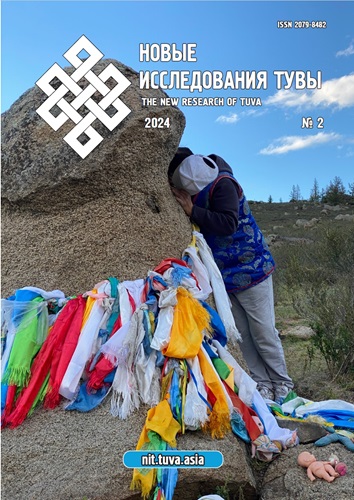Kadak is a scarf of offering and consecration (from the history of tradition)
DOI:
https://doi.org/10.25178/nit.2024.2.10Keywords:
Tuvan culture; ritual ribbon; traditional rituals; shamanism; Buddhism; ceremonial scarves; kadak; greeting; etiquette; ; culture of ribbons and flagsAbstract
The article analyzes the history of the traditional Tuvan ritual scarf, or “kadak”. Etymological research shows that the name of the scarf is derived from the Tibetan language, and it came into use in Tuvan culture as a result of the influence of both Tibetan Buddhist and non-Buddhist traditions, with significant influence from Mongolian Buddhism. This can be seen in the adoption of practices and rituals from both traditions.
The peaceful coexistence of Buddhism and Shamanism in Tuvan society led to the widespread use of kadak scarves by shamans in rituals. Eyewitness accounts from the late 19th and early 20th centuries, as well as subsequent ethnographic research, confirm that kadaks become an integral part of the shamanic tradition in Tuva.
Kadaks were not only used in shamanic rituals, but also in Buddhist religious ceremonies. They were often paired with colored chalama ribbons, which were also an important part of shamanic practice. Kodaks were also used in Buddhist religious rituals in Tuva. In addition to their religious significance, the symbolism of the offering, which originated in Tibetan pre-Buddhist culture, was also adopted. This tradition was combined with the Tuvan custom of presenting ribbons made from animal skins.
The strong connection between Kodaks and Tuvan culture is evident in the symbols used by the Tuvan People's Republic, which was restored after the Soviet era. The complex history of ribbons in Tuva shows that the region is part of a larger, diverse culture of ribbons and flags that spans the Eurasian steppes.
References
Basilov, V. N. (1992) Shamanism among the peoples of Central Asia and Kazakhstan. Moscow, Nauka. 328 p. (In Russ.).
Bezertinov, R. N. (2011) China and the nomadic world (1500 BC to 220 AD). Kazan', Slovo Publ. 208 p. (In Russ.).
Berzin, A. (1992) Tibetan Buddhism: Its history and Development Prospects. Moscow, Traditsionnaia meditsina. 31 p. (In Russ.).
Berzin, A. (2006) Selected works on Buddhism and Tibetology. Moscow, Otkrytyi Mir. 208 p. (In Russ.).
Bir, R. (2011) Encyclopedia of Tibetan Symbols and Ornaments / transl. from Engl. by L. Bubenkovoi. Moscow, Orientaliia. 428 p. (In Russ.).
Bicheldei, K. A. and Mongush, B. B. (2019) State symbols of Tuva: coat of arms, flag and anthem, monetary and postal signs. Kyzyl, Tuvinskoe knizhnoe izdatel'stvo im. Yu. Sh. Kiunzegesha. 112 p. (In Russ.).
Biche-ool, S. M. (2018) Traditional marriage and family relations among Tuvans and their transformation in the Soviet period. Abakan, Zhurnalist. 126 p. (In Russ.).
Vainshtein, S. I. (1991) The world of the nomads of Central Asia. Moscow, Nauka. 294 p. (In Russ.).
Gerasimova, G. M. (1989) Traditional beliefs of Tibetans in the cult system of Lamaism. Novosibirsk, Nauka, Sibirskoe otdelenie. 317 p. (In Russ.).
David-Neel', A. (2004) Initiations and initiates in Tibet. Moscow, Tsentrpoligraf. 236 p. (In Russ.).
Dorzhigushaeva, O. V. and Kipliuks, A. V. (2023) Ecologization of the tradition of tying zurams, khadaks and khii-morins at places of worship in the Republic of Buryatia. New Research of Tuva, no. 4, pp. 328–343. (In Russ.). DOI: https://doi.org/10.25178/nit.2023.4.23
D'iakonova, V. P. (1977) Religious cults of Tuvans. In: Cultural monuments of the peoples of Siberia, the peoples of Siberia and the North (the second half of the XIX — the beginning of the XX century / ed. by D. A. Ol'derroge. Leningrad, Nauka, Leningradskoe otdelenie. 235 p. Pp. 172–216. (In Russ.).
Ekeeva, E. V. and Belekova, E. A. (2018) Cult attributes in the traditional worldview of the Altai people. Gorno-Altaisk, BNU RA «Nauchno-issledovatel'skii Institut altaistiki im. S. S. Surazakova». 119 p. (In Russ.).
Zherebina, T. (2009) Siberian Shamanism: an Ethnocultural Atlas. St. Petersburg, TID Amfora. 623 p. (In Russ.).
Zhukovskaia, N. L. (1977) Lamaism and early forms of religion. Moscow, Nauka, Glavnaia redaktsiia vostochnoi literatury. 199 p. (In Russ.).
Zhukovskaia, N. L. (2002) Nomads of Mongolia. Culture. Traditions. Symbolism. Moscow, Vostochnaia literatura. 246 p. (In Russ.).
The history of Tuva (2007) / ed. by V. A. Lamin. Novosibirsk, Nauka. 430 p. (In Russ.).
Kairbekov, B. (2011) National customs and traditions. Kazakh etiquette. Almaty, s. n. 109 p. (In Russ.).
Katanov, N. F. (2011) Essays of the Urianhai land. Diary of a journey performed in 1889 on behalf of the Imperial Academy of Sciences and the Imperial Russian Geographical Society. Kyzyl, TIGI pri Pravitel'stve RT. 383 p. (In Russ.).
Kenin-Lopsan, M. B. (2009) Tuvan shamans. Moscow, OOO «IPTs “Maska”». 325 p. (In Russ.).
Kurasov, S. V. (2020) The color semiotics of Tibetan Buddhist art: the genre of the tank. Language. Philology. Culture, vol. 10, issue 1–2, pp. 10–19. (In Russ.).
Lamazhaa, Ch. K. (2023) Kontsepty kul’tury: forma, ideia, sotsial’naia reguliatsiia. New Research of Tuva, no. 1, pp. 6–25. (In Russ.). DOI: https://doi.org/10.25178/nit.2023.1.1
Lamazhaa, Ch. K. and Mainy, Sh. B. (2020) Tuvan Wedding Rites: from Establishment of Family Ties to Social Presentation. Oriental Studies, vol. 13, no. 2, pp. 405–421. (In Russ.). DOI: https://doi.org/10.22162/2619-0990-2020-48-2-405-421
Lamazhaa, Ch. K., Sanchai, Ch. Kh. and Mongush, A. V. (2023) Ritual ribbons and flags in the practical activities of contemporary Tuvans. New Research of Tuva, no. 4, pp. 344–370. (In Russ.). DOI: https://doi.org/10.25178/nit.2023.4.24
Lamazhaa, Ch. K., Suvandii, N. D. and Mongush, A. V. (2023) The Sacred in Tuvan Culture: Past and Modernity. New Research of Tuva, no. 3, pp. 220–241. (In Russ.). DOI: https://doi.org/10.25178/nit.2023.3.14
Leont'eva, L. (2012) A guide to Buddhism. The Illustrated Encyclopedia. Moscow, Eksmo. 256 p. (In Russ.).
Mongush, M. V. (2001) The history of Buddhism in Tuva. Novosibirsk, Nauka. 197 p. (In Russ.).
Oinotkinova, N. R. (2015) On some results of a field study of the modern ceremonial folklore of the Altaians. Yazyki i fol'klor korennykh narodov Sibiri, no. 1(28), pp. 50–55. (In Russ.).
Orus-ool, S. M. (2010) Folklore materials in 7-volume “Uryankhay. Tyva Depter” book. New Research of Tuva, no. 3, pp. 184–202. (In Russ.).
Pozdneev, A. (1887) Essays on the life of Buddhist monasteries and Buddhist clergy in Mongolia. St. Petersburg, Tip. Imperat. akad. Nauk. 492 p. (In Russ.).
Popkov, Yu. V. (2023) Ethnocultural Neotraditionalism: Reflexive Integration Theoretical Model. Etnografiia, no. 3 (21), pp. 203–223. (In Russ.). DOI: https://doi.org/10.31250/2618-8600-2023-3(21)-203-223
Potapov, L. P. (1960) Materials on the ethnography of the Tuvans of the Mongun-Taiga and Kara-Khol districts. In: The works of the Tuvan complex archaeological and ethnographic expedition / ed. by L. P. Potapov. Moscow, Leningrad, Izd-vo Akademii nauk SSSR, Leningradskoe otd-ie. Vol. 1: Materials on archeology and ethnography of Western Tuva. 317 p. Pp. 171–237. (In Russ.).
Potapov, L. P. (1969) Essays on the everyday life of Tuvans. Moscow, Nauka. 400 p. (In Russ.).
Rakhimov, R. N., Aznabaev, B. A. and Frolova, I. V. (2022) The image of a horseman in the sunlight: Heraldic cases of Bashkortostan and Tuva. New Research of Tuva, no. 3, pp. 226–240. (In Russ.). DOI: https://doi.org/10.25178/nit.2022.3.15
The religious landscape of Western Siberia and adjacent regions of Central Asia (2014) / ed. by P. K. Dashkovskii. Barnaul, Izd-vo Alt. un-ta. Vol. 1: Late antiquity — the beginning of the twentieth century. 214 p. (In Russ.).
The religious landscape of Western Siberia and adjacent regions of Central Asia (2015) / ed. by P. K. Dashkovskii. Barnaul, Izd-vo Alt. un-ta. Vol. 2: The twentieth century. 194 p. (In Russ.).
The religious landscape of Western Siberia and adjacent regions of Central Asia (2017) / ed. by P. K. Dashkovskii. Barnaul, Izd-vo Alt. un-ta. Vol. 3. The end of the XX — beginning of the XXI century. 190 p. (In Russ.).
Suraganova, Z. K. (2009) Exchange of gifts in the Kazakh traditional culture. Astana, KAM-Mediaprint. 192 p. (In Russ.).
Tatarintsev, B. I. (2009) Selected scientific works. Kyzyl, Tyvaoligraf. 287 p. (In Russ.).
Tatarintsev, B. I. (1976) Mongolian linguistic influence on Tuvan vocabulary. Kyzyl, Tuvinskoe knizhnoe izdatel'stvo. 130 p. (In Russ.).
Tuva: Native land (2023) / Lamazhaa Ch. K., Suvandii N. D., Kuzhuget Sh. Yu., Mainy Sh. B. and Sanchai Ch. Kh.; ed. by Ch. K. Lamazhaa and N. D. Suvandii. St. Petersburg, Nestor-Istoriia. 344 p. (In Russ.).
Khudiakov, Iu. S., Borisenko, A. Iu. and Orozbekova, Zh. (2016) The symbolism of spears, bunchukas and banners in the traditional culture of the Kyrgyz (Tien Shan and Alai). Etnograficheskoe obozrenie, no. 3, pp. 162–179. (In Russ.).
Sherstova, L. I. (2010) Burkhanism: the origins of Ethnicity and religion. Tomsk, Tomskii gos. un-t. 285 p. (In Russ.).
Iuan'pen, Kh., Alekseeva, G. V. and Tintin, Ts. (2020) Tibetan culture of the Yellow River Basin in the works of modern Chinese artists. IKONI, no. 4, pp. 25–37. (In Russ.).
Yakovlev, E. K. (1900) An ethnographic review of the non-native population of the Southern Yenisei Valley. Minusinsk. Issue IV. Description of the Minusinsk Museum. 357 p. (In Russ.).
Martin, E. (2016) Gift, Greeting or Gesture: The Khatak and The Negotiating of Its Meaning On The Anglo-Tibetan Borderlands. Himalaya, no. 35(2), pp. 56–72.
Modi, J. J. (1918) Tubetan salutations and a few thoughts suggested by them. In: Anthropological Papers. Part II; Papers read before the Anthropological Society of Bombay; The British India Press, 1918. 369 p. P. 110–123.
Li Tao and Jiang Hong Ying (2003) Tibetan customs. China Intercontinental Press. 126 p.
Rabten, T. (2003) A brief discussion of the origin and characteristics of the decorative design on Tibetan rlung rta (prayer flags). In: Proceedings of the tenth seminar of the IATS. Vol. 13: Art in Tibet / ed. by E. Lo Bue. 2011. xi, 336 p.
Rockhill, W. W. (1894) Diary of a journey through Mongolia and Tibet in 1891 and 1892. Washington, Smithsonian institution. XX, 413 p.
Wedemeyer, C. K. (2004) Bon. In: Encyclopedia of Buddhism / Ed. by R. E. Buswell. New York [etc.], Macmillan Reference. Vol. 1: A-L. 1042 p. Pp. 66–68.
Published
How to Cite
For citation:
Lamazhaa Ch. K., Shaimerdenova M. J. Kadak is a scarf of offering and consecration (from the history of tradition). New Research of Tuva, 2024, no. 2, pp. 152-176. (In Russ.). DOI: https://doi.org/10.25178/nit.2024.2.10
Issue
Section

This work is licensed under a Creative Commons Attribution-NonCommercial 4.0 International License.

Author(s) license holder(s) grant rights for their work to the journal (grantee of a license) under the simple non-exclusive open license in accordance with Art. 1286.1 «Open license for a research work, work of literature or fine arts», Civil Code of the Russian Federation.
New Research of Tuva publishes articles under the Creative Commons Attribution-NonCommercial license (CC BY-NC).
Since it is an open license, author(s) reserve the right to upload the article to their institutional repository, submit it to another journal (if it allows republications), or republish it on their own website (in full, or in part).
However, several conditions apply here:
a) The republished version must always contain the name(s) and affiliation(s) of the author(s), the original title and the hyperlink to the original version on the New Research of Tuva website;
b) It must be in open access, free of charge, and no category of readers must be in any way whatsoever advantaged over general readership.
c) should the contribution be submitted elsewhere by its author(s) without substantial modification (30% or more of original text unchanged), the body of the article should contain a disclaimer that the original version was published in New Research of Tuva (with a link to the respective page)
The CC-BY-NC is a non-revocable license which applies worldwide and lasts for the duration of the work’s copyright.










